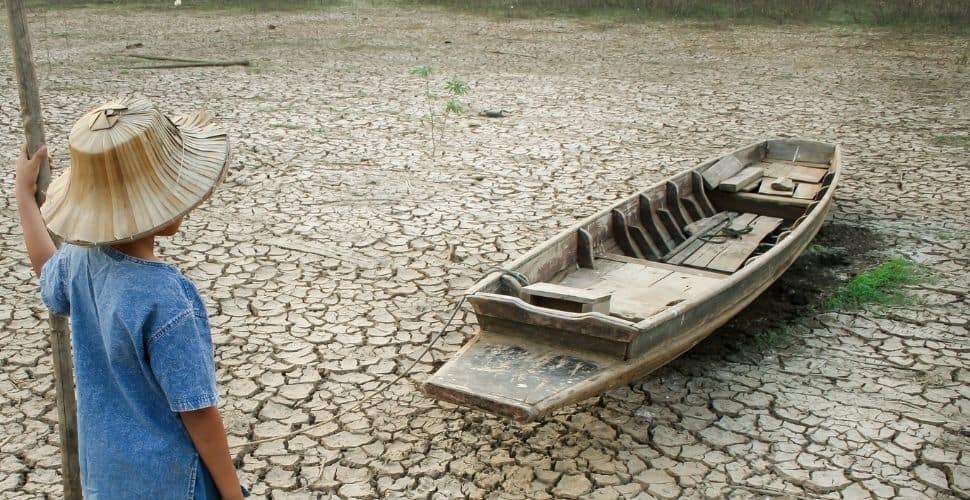Read our joint letter to world leaders urgently calling on them to recognize the link between climate-induced migration and modern slavery – and take action to mitigate risks.
The report heard around the world
The world has been united in horror following the “code red for humanity” declared in the new report by the Intergovernmental Panel on Climate Change (IPCC). This declaration follows months of news about wildfires in the Pacific Northwest, Turkey, and Greece; stories of the harrowing reality of deadly floods in China, Belgium, Germany, Nigeria, and Costa Rica, as well as record-breaking temperatures in Canada and Italy.
Climate change is already impacting people around the world and the IPCC has undeniable evidence of what is driving it: rising emissions and inaction from international governments. As is true of most crises, the hardest hit are often the poorest regions of the world.
The conclusion is clear and damning –not only are we failing to protect each other from modern slavery but humanity also gets a failing grade when it comes to protecting the one home we have.
What’s the connection to modern slavery?
Climate change and modern slavery are interlinked through a horrifying cycle in which one feeds into the other, as laid out in Anti-Slavery International’s report From a Vicious to a Virtuous Circle. Like modern slavery, the consequences of climate change come with a human cost, driving inequality and, in some cases, leading to new vulnerabilities to exploitation as a result caused by forced climate migration and the loss of livelihoods.
An example of this nexus between climate change and modern slavery was evident when Super Typhoon Haiyan made landfall on 8 November 2013. The typhoon brought catastrophic loss of life and livelihoods in Southeast Asia, particularly the Philippines. It affected 16,078,181 individuals, resulted in 6,300 deaths, and displaced 4.4 million people. The International Labour Organisation (ILO) reported that traffickers preyed on displaced men, women, and children, many of whom were struggling to cope with the death of family members and the destruction of their houses and livelihoods.
Indigenous communities have played a key role in resisting environmental destruction occurring on their doorstep and protecting vital local ecosystems. In doing so, indigenous communities have risked their lives, with 331 indigenous activists murdered in 2020 alone.
We recently documented how indigenous peoples are already at higher risk to trafficking due to a myriad of factors perpetuated by the legacy of colonization and neo-colonial practices, including extractivism in their territories whereby natural resources are dangerously depleted by transnational companies. Climate change and environmental degradation is making it increasingly difficult for indigenous communities to live off traditional lands, placing them at greater risk of accepting exploitative work as their livelihoods are affected.
Poverty, barriers to employment and education, political marginalization, and forced dispersal from traditional territories have further contributed to the systemic marginalization of indigenous communities, empowering traffickers to exploit these communities who have been pushed to the fringes of society.
Along with the current global pandemic, climate change is undermining efforts to effectively build resilience to trafficking and exploitation. We need holistic action for sustainable change.
Products of exploitation
The connection between modern slavery and environmental destruction is not new. Industries connected to deforestation and pollution, such as deforestation from illegal mining in Peru, emissions from brick kilns in Cambodia, and pollution from cobalt mines in southern Congo, are too often linked to forced labor.
Palm oil is one industry that’s been placed under scrutiny from anti-slavery organizations and environmental groups alike. A natural oil from a variety of palm trees, it’s low cost with high profit margins and ends up on our shelves as a key ingredient in popular foods, such as chocolate, and cosmetics. Palm oil is also a key driver of devastating levels of deforestation which in turn contributes to the release of millions of tons of greenhouse gases into the atmosphere. The human cost? Rampant forced labor, including most disturbingly, forced child labor in the harvesting process.
This alarming reality is why, in 2019, we partnered with Rainforest Action Network and Sum of Us to successfully get the United States Customs and Border Protection (CBP) to place a ban on U.S. imports of palm oil from Malaysia where some of the largest palm oil plantations are situated with suppliers implicated in forced labor. The alliance between environmental organizations and anti-slavery organizations proved fruitful and mobilized a global audience to demand change that could not be ignored.
Like in the case of palm oil, many of the products we buy have a hidden cost. From mobile phones to the clothes we wear, our everyday products are having detrimental impacts on people and the planet.21 Environmental damage often leaves rural and native populations without natural resources and habitats they are dependent on by polluting rivers, deforestation, and mining.
“The edge of extinction”
In many parts of the world, forced climate migration and displacement are already a reality. Climate change is threatening livelihoods in countries across the world and has led to climate refugees and cross-country climate migration. Some examples of this include:
- Guatemalans were forced to migrate in early 2019 due to drought, flood, bankruptcy, and starvation, a direct result of climate change.
- Bangladeshi families, previously reliant on the land for their livelihoods, face dire poverty and the impossible choice between feeding their families and marrying off their daughters due to severe flooding.
- Droughts across India drive communities from rural areas into nearby cities in search of income who are then taken advantage of by traffickers, trapping persons into working in brick kilns and forced sex work.
- Cross-country climate migration in Cambodia due to exacerbated drought, contributed to workers being coerced into exploitative work and forced labor on fishing vessels in Thailand.
But IPCC’s report tells us that we haven’t seen the worst yet. A recent IOM report argues that as a result of extreme environmental changes, there could be as many as 200 million climate refugees by 2050.
With global sea levels projected to rise by six to 12 inches(15 to 30 centimeters) by 2050, low-lying countries are in extreme danger. Responding to the IPCC report, former Maldives president, Mohamed Nasheed despairs, “It confirms we are on the edge of extinction. Climate emergency is intensifying, we are on the front lines.”
What we know is that migrant workers and refugees are already being denied the protection and support they require to avoid being trapped in exploitative conditions. If we continue down this path, there will be whole populations displaced and that vulnerability means they’re likely to take bigger risks and be forced to accept exploitative conditions they would have previously been able to reject.
To reduce modern slavery driven by climate change, we must work towards preventing forced climate migration by pushing for adequate climate action. Where that is already too late, global governments should offer adequate protection that migrants and refugees require to avoid being forced to accept exploitative conditions such as debt bondage, human trafficking, forced marriage, and forced labor.
How climate inaction affects modern slavery
The cost of inaction on climate change is hugely concerning but what the IPCC does not examine is how climate change is also increasing modern slavery risks.
The IPCC report makes clear that human-induced climate change exacerbates drought, sea levels, wildfires, and flooding. These are key factors driving poverty and displacement which put poorer people without effective safety nets at risk of falling into precarious work, debt bondage, and human trafficking as they look for ways to survive and traffickers see an opportunity to benefit.
If climate change is not addressed, whilst protection measures and prevention of modern slavery remain weak, we will see increasing vulnerability to forced labor and human trafficking.
The IPCC evidence is clear that we are on the path to increasing extreme weather events, and, as a consequence, anti-slavery efforts are being undermined by a lack of action to address the climate crisis.
What are the solutions?
With the IPCC report indicating a “code red” and over 40 million people in modern slavery, it’s difficult not to feel like all hope is lost. But there are solutions that anti-slavery organizations and environmental groups can achieve if we work together.
One of Freedom United’s advisors, Kevin Bales, a long-time advocate against modern slavery, underscores the need to collaborate across sectors when he says:
…up until now, the study of human rights (and slavery in particular), and the study of its anthropogenic impacts on the climate have been falsely seen as distinct and separate issues and areas of inquiry. Human rights, however, do not exist in isolation from the natural environment; and the detrimental impact of anthropogenic change on the natural environment can be exacerbated by the diminution of human rights. This separation of the cultural, social, and legal from the natural and environmental is a false and potentially fatal dichotomy, one that only entrenches “climate precarity”. The nascent idea of their interrelatedness may be clear within some policy frameworks, but where it has failed to gain traction is at the sharp end of both human rights violations and environmental destruction.”
His argument should be a rallying cry for environmentalists and anti-slavery advocates to work together where possible. Success cannot be found in silos. As with all modern slavery cases, we must build an informed understanding by listening to and supporting communities on the front lines of the crossover between climate change and modern slavery.
Indigenous communities are taking the lead in exposing the consequences of environmental injustice. They are tackling climate change, and protecting native lands and ecosystems despite lacking adequate support which creates vulnerability to exploitative work and modern slavery. Indigenous communities should be supported by both the environmental and anti-slavery movements and include their voices.
Tackling climate change must be a collective effort. For that, we need a strong legal framework that mandates corporate human rights and environmental due diligence so that corporations are held to account for human and environmental consequences in supply chains to disincentivize environmental destruction and modern slavery in supply chains.
The IPCC report makes evident that on our current path, there will be increased environmental instability. We know that this increases the risk of forced labor and human trafficking. Given that current levels of climate change and modern slavery are already at alarming rates, we cannot afford to continue as we are.
We must stand together to put people and the planet first so that profit is no longer made from forced labor, human trafficking and environmental devastation. If we do this, then we can be hopeful that we can move from a “code red” to a “code green”.







Clearly it’s a huge issue, and it’s great to finally see different organisations that are working on separate important issues for the creating of a better world recognise that actually it is all linked and it’s only through working together we will create the world we need. Bravo Freedom United!